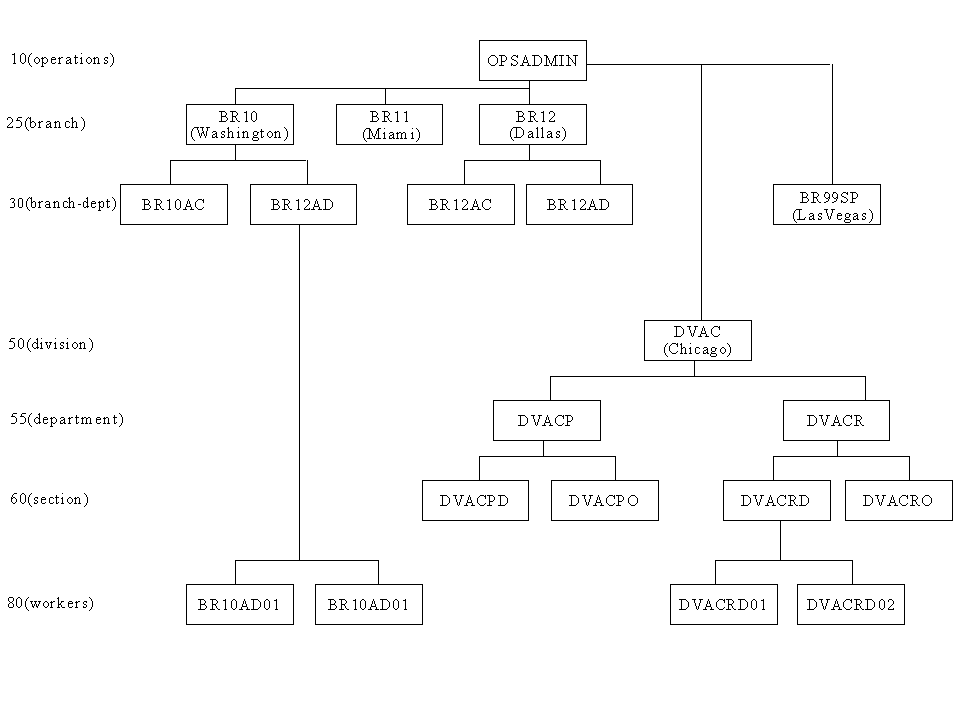Conceivably, you can end up with thousands of recipients in the tree. It is recommended, therefore, that you set standards for recipient naming conventions. Remember that you have up to eight characters for defining the recipient name. It will benefit the implementation if you set easy-to-follow standards. It will also help in any post-implementation work that may be required (such as adding new recipients and applications to the tree).
Develop a Standard
In our example, the user has created a standard based on the organization of the company. There are two distinct structures: the head office and the branches. They have developed a standard for both:
Branch Naming Conventions
The naming standard for the branches is built in the format:
BRxxaann
where
Head Office Naming Conventions
The naming standard for the head office is built in the following format:
DVaaxsnn
where
Assign the Standard
In the following example, we will assign standards to the users of our sample application. The recipient name is built according to the location of the recipient, using our sample standards:
Table 14 Sample Assignment Standards to Users
Level |
Assignment |
|
|---|---|---|
10 |
OPERATIONS |
|
|
Operations (Control-D) Administration User (OPSADMIN) |
|
15 |
PRESIDENT |
|
20 |
REGNL-MGMT |
|
25 |
BRANCH |
|
|
Mrs. Robinson, Branch Manager, Branch 11, Miami (BR11) |
|
30 |
BRANCH-DEPT |
|
|
Accounts Department, Washington (BR10AC) |
|
Administration Department, Branch 12, Dallas (BR12AD) |
||
Accounts Supervisor, Branch 12, Dallas (BR12AC) |
||
Special Accounts Manager, Las Vegas (BR99SP |
||
50 |
DIVISION |
|
|
Tom Farmer, Chief Accountant, Accounts Division, Chicago (DVAC) |
|
55 |
DEPARTMENT |
|
|
Department Manager, Accounts Receivable, Chicago (DVACR) |
|
60 |
SECTION |
|
|
Accounts Payable (Domestic), Chicago (DVACPD) |
|
80 |
WORKERS |
|
|
Accounts Clerk, Accounts Receivable (Domestic), Chicago (DVACRD01) |
|
90 |
CD-CONTROL |
|
95 |
OP-USER |
|
The format of the whole application in the recipient tree would look like this:
Figure 4 Sample Full Recipient Tree

Benefits of Standards
Having set these standards, a recipient’s name tells us where in our structure the recipient is placed and also provides us with other information about the recipient (for example, by looking at a recipient named BR10AD01, we can tell that this recipient is in Branch 10 (Washington) in the Administration Department).
When you come to implement future applications, you can use the same standards and assign new application ids, department codes, and so on.
Summary
Another alternative for recipient naming is the use of userids. You can use one of the supplied utilities (see Step 4) to automatically create a recipient tree using userids as recipient names. This can be a good method if most of the recipients are on the same level (such as might be the case with the data center programmers).
Normally each recipient will be a specific user. However, Control-D allows a recipient name to be shared by a group of users, such as a branch or section.
You can, of course, assign any standards that you feel are relevant for your site. Ensure that whatever standards you do set are known and followed by all members of your implementation team.
Note: You should by now have set standards for your recipient names.
Parent Topic |